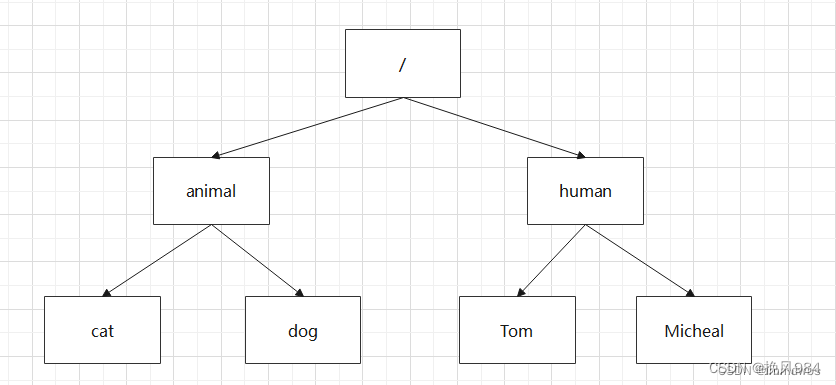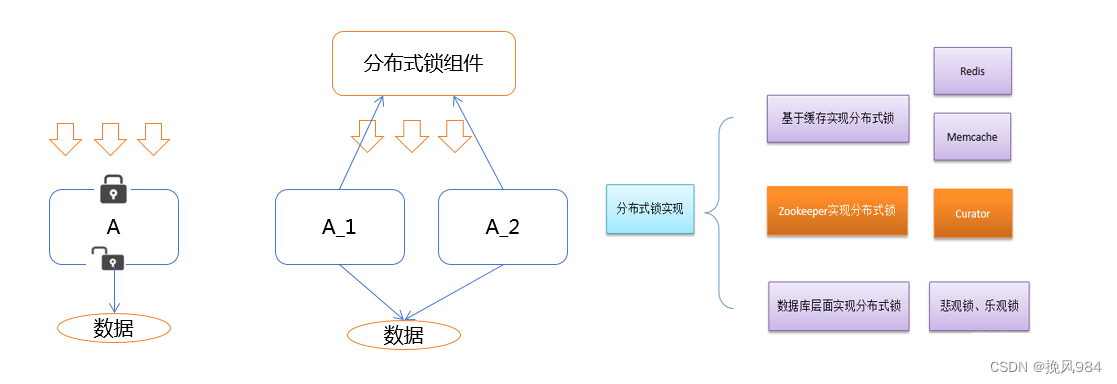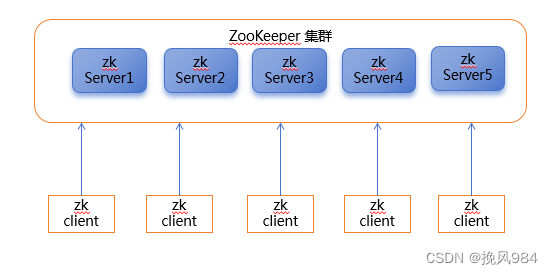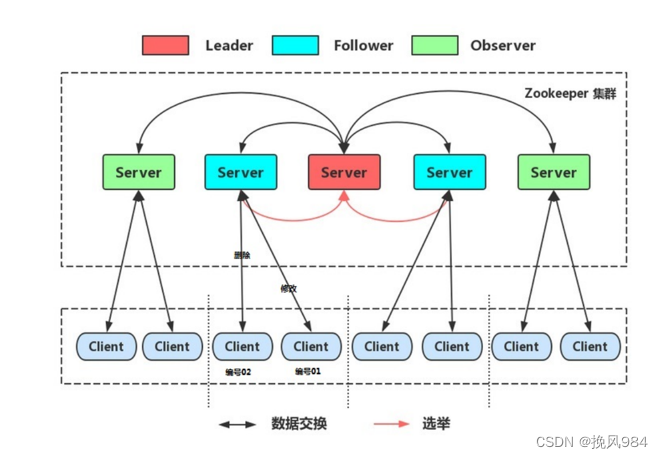zookeeper
在学习zookeeper之前,我们还是先了解它的概念:
一、什么是zookeeper?
1、简介
zookeeper 是一个开放源码的分布式协调服务,主要为了解决分布式架构下数据一致性问题, 它是集群的管理者, 监视着集群中各个节点的状态,根据节点提交的反馈进行下一步合理操作。 最终, 将简单易用的接口和性能高效、 功能稳定的系统提供给用户
2、应用场景
分布式配置中心、分布式注册中心、分布式锁、分布式队列、集群选举、分布式屏障、发布/订阅等场景。
二、zookeeper数据结构
1、简介
zookeeper的数据模型类似于文件系统,是树状结构,每个树节点(目录)对应一个znode节点。这些目录节点和我们普通的目录一样可以新建、删除、修改。

2、常用的数据格式有:
我们常用的主要有四种类型的znode。
1、持久化目录节点:persistent 客户端与zookeeper断开连接后,该节点依旧存在,只要不手动删除该节点,他将永远存在。
2、持久化顺序编号目录节点:persistent_sequential : -s 客户端与zookeeper断开连接后,该节点依旧存在,只是zookeeper给该节点名称进行顺序编号。
3、临时目录节点:ephemeral : -e 客户端与zookeeper断开连接后,该节点被删除。
4、临时顺序编号目录节点: ephemeral_sequential : -es 客户端与zookeeper断开连接后,该节点被删除,只是zookeeper给该节点名称进行顺序编号。
3、zookeeper客户端常用命令:
1)、连接zookeeper服务端(linux): ./zkcli.sh -server ip:port
2)、断开zookeeper服务端的连接: quit
3)、查看帮助: help
4)、查询所有的目录节点: ls /
5)、创建目录节点: create /节点名 值(可写可不写)
6)、设置目录节点的值(修改时也可以): set /节点名 值
7)、删除单个目录节点: delete /节点名
8)、删除带有子节点的目录: deleteall /节点名
9)、创建临时目录节点: create -e /节点名 值(可写可不写)
10)、创建持久化目录节点: create -s /节点名 值(可写可不写)
11)、查询目录节点的详情信息: ls -s /节点名
三、zookeeper javaapi(curator)
1、简介:
apache curator 是一个用于apache zookeeper 的java 客户端框架。 curator 提供了一组易于使用的api和工具,简化了与zookeeper 的交互,同时提供了更高级别的抽象和功能。
2、搭建和使用curator(以下环境使用的是spring boot)
1)、引入curator支持
<!-- zookeeper支持 -->
<dependency>
<groupid>org.apache.zookeeper</groupid>
<artifactid>zookeeper</artifactid>
<version>3.6.4</version>
</dependency>
<!-- curator-recipes -->
<dependency>
<groupid>org.apache.curator</groupid>
<artifactid>curator-recipes</artifactid>
<version>5.5.0</version>
</dependency>
<!-- curator-framework -->
<dependency>
<groupid>org.apache.curator</groupid>
<artifactid>curator-framework</artifactid>
<version>5.5.0</version>
</dependency>2)、连接zookeeper客户端
//超时重试(连接间隔时间和超时连接次数)
retrypolicy retrypolicy = new exponentialbackoffretry(1000, 5);
//连接zookeeper对象
client = curatorframeworkfactory.newclient(
"ip:port",
1000,
60*1000,
retrypolicy);
//开始连接
client.start();
3)、创建节点
//1、创建节点并赋值
string path = client.create().forpath("/zuxia","helloworld".getbytes());
system.out.println("创建节点:"+path);
//2、创建节点带子节点(如果不给子节点赋值,子节点的值默认为当前系统的ip地址)
string path = client.create().creatingparentsifneeded().forpath("/zuxia/abc");
system.out.println("创建节点:"+path);
//3、创建临时节点(当断开连接时临时节点会自动删除,withmode中的属性可选择)
string path =client.create().withmode(createmode.ephemeral).forpath("/a","helloworld".getbytes());
system.out.println("创建节点:"+path);
4)、查询节点
//1、查询节点的数据
byte[] bytes = client.getdata().forpath("/zuxia");
system.out.println(new string(bytes));
//2、查询节点的数据(详情信息)
stat stats=new stat();
system.out.println(stats);//为了区分两个结果的不同
byte[] be = client.getdata().storingstatin(stats).forpath("/zuxia");
system.out.println(stats);
5)、更新节点
//给节点赋值(返回值为stat,可写可不写)
client.setdata().forpath("/ab", "hello".getbytes());
6)、删除节点
//1、删除节点
system.out.println("删除节点:"+client.delete().forpath("/wjh"));
//2、删除带有子节点的目录节点
system.out.println("删除子节点:"+client.delete().deletingchildrenifneeded().forpath("/zuxia"));
7)、watch事件监听
•zookeeper 允许用户在指定节点上注册一些watcher,并且在一些特定事件触发的时候,zookeeper 服务端会将事件通知到感兴趣的客户端上去,该机制是 zookeeper 实现分布式协调服务的重要特性。
•zookeeper 中引入了watcher机制来实现了发布/订阅功能能,能够让多个订阅者同时监听某一个对象,当一个对象自身状态变化时,会通知所有订阅者。
•zookeeper提供了三种watcher:
nodecache : 只是监听某一个特定的节点
pathchildrencache : 监控一个znode的子节点.
treecache : 可以监控整个树上的所有节点,类似于pathchildrencache和nodecache的组合
1、nodecache 监听事件
@test
void testnodecache() throws exception {
// 1. 创建nodecache
nodecache nodecache = new nodecache(client, "/ab");
// 2. 注册监听
nodecache.getlistenable().addlistener(new nodecachelistener() {
@override
public void nodechanged() throws exception {
system.out.println("/ab节点发生变更");
byte[] databytes = nodecache.getcurrentdata().getdata();
system.out.println("节点修改后的数据:" + new string(databytes));
}
});
// 3. 开启监听,如果设置为true,则开启监听时,加载缓冲数据
nodecache.start(true);
while(true){}
}2、pathchildrencache 监听事件
@test
void testpathchildrencache() throws exception {
//创建监听对象(监听指定节点下的)
pathchildrencache pathchildrencache= new pathchildrencache(client, "/zuxia", true);
//注册监听事件
pathchildrencache.getlistenable().addlistener(new pathchildrencachelistener() {
@override
public void childevent(curatorframework cf, pathchildrencacheevent event) throws exception {
system.out.println("节点发生变化了");
pathchildrencacheevent.type type = event.gettype();
//当前判断的是当节点发生更新时进入改方法,可以选择添加或者删除的方法
if (type.equals(pathchildrencacheevent.type.child_updated)){
byte[] bytes = event.getdata().getdata();
system.out.println("节点修改后的数据"+new string(bytes));
}
}
});
//开启监听
pathchildrencache.start();
while (true){}
}3、treecache 监听事件
@test
void testtreecache() throws exception {
//创建监听对象
treecache treecache = new treecache(client, "/zuxia");
//注册监听
treecache.getlistenable().addlistener(new treecachelistener() {
@override
public void childevent(curatorframework curatorframework, treecacheevent treecacheevent) throws exception {
system.out.println("节点发生变化了");
treecacheevent.type type = treecacheevent.gettype();
if (type.equals(treecacheevent.type.node_added)){
system.out.println("节点添加了");
}
}
});
//开启监听
treecache.start();
while (true){}
}
8)、分布式锁实现
-
首先我们要了解什么是分布式锁?
在我们进行单机应用开发,涉及并发同步的时候,我们往往采用synchronized或者lock的方式来解决多线程间的代码同步问题,这时多线程的运行都是在同一个jvm之下,没有任何问题。
但当我们的应用是分布式集群工作的情况下,属于多jvm下的工作环境,跨jvm之间已经无法通过多线程的锁解决同步问题。
那么就需要一种更加高级的锁机制,来处理种跨机器的进程之间的数据同步问题——这就是分布式锁。
-

-
其次也要悉知分布式锁的原理:
核心思想:当客户端要获取锁,则创建节点,使用完锁,则删除该节点。
1.客户端获取锁时,在lock节点下创建临时顺序节点。
2.然后获取lock下面的所有子节点,客户端获取到所有的子节点之后,如果发现自己创建的子节点序号最小,那么就认为该客户端获取到了锁。使用完锁后,将该节点删除。
3.如果发现自己创建的节点并非lock所有子节点中最小的,说明自己还没有获取到锁,此时客户端需要找到比自己小的那个节点,同时对其注册事件监听器,监听删除事件。
4.如果发现比自己小的那个节点被删除,则客户端的
watcher会收到相应通知,此时再次判断自己创建的节点
是否是lock子节点中序号最小的,如果是则获取到了锁,
如果不是则重复以上步骤继续获取到比自己小的一个节点
并注册监听。
-

-
案例操作----模拟12306售票:
•在curator中有五种锁方案:
•interprocesssemaphoremutex:分布式排它锁(非可重入锁)
•interprocessmutex:分布式可重入排它锁
•interprocessreadwritelock:分布式读写锁
•interprocessmultilock:将多个锁作为单个实体管理的容器
•interprocesssemaphorev2:共享信号量
方法类:
package com.wjh; import org.apache.curator.retrypolicy; import org.apache.curator.framework.curatorframework; import org.apache.curator.framework.curatorframeworkfactory; import org.apache.curator.framework.recipes.locks.interprocessmutex; import org.apache.curator.retry.exponentialbackoffretry; import java.util.concurrent.timeunit; public class ticktest implements runnable{ private int x=10;//票数 //创建分布式可重入排它锁对象 private interprocessmutex lock; curatorframework client; //当前方法的构造方法 public ticktest() { //超时重试(连接间隔时间和超时连接次数) retrypolicy retrypolicy = new exponentialbackoffretry(1000, 5); //连接zookeeper对象 client = curatorframeworkfactory.newclient( "ip:port", 1000, 60*1000, retrypolicy); //开始连接 client.start(); //创建分布式可重入排它锁对象连接zookeeper注册中心客户端 //客户端中不用创建,这里会自动创建 lock = new interprocessmutex(client, "/lock"); } @override public void run() { try { //设置锁 lock.acquire(3, timeunit.seconds); while (true) { if(x>0){ //输出的调用线程的对象以及票数的数量 system.out.println(thread.currentthread()+"票数:" + x); //间隔200毫秒输出一次 thread.sleep(200); x--; } } } catch (exception e) { throw new runtimeexception(e); }finally { try { //释放锁 lock.release(); } catch (exception e) { throw new runtimeexception(e); } } } }
测试类:
package com.wjh;
public class maitest {
//使用main方法调用
public static void main(string[] args) {
//实现线程方法
ticktest tick = new ticktest();
//创建线程对象
thread t1 = new thread(tick,"携程");
thread t2 = new thread(tick,"飞猪");
//启动线程
t1.start();
t2.start();
}
}
三、zookeeper集群搭建
1、zookeeper集群介绍
leader选举:
比如有三台服务器,编号分别是1,2,3。
编号越大在选择算法中的权重越大。
服务器中存放的最大数据id.值越大说明数据 越新,在选举算法中数据越新权重越大。
获得了超过半数的选票,
则此zookeeper就可以成为leader了

2、zookeeper集群搭建
附录文件上有详细搭建步骤.....
四、zookeeper核心理论
在zookeeper集群服中务中有三个角色:
•leader 领导者 :
-
处理事务请求
-
集群内部各服务器的调度者
•follower 跟随者 :
-
处理客户端非事务请求,转发事务请求给leader服务器
-
参与leader选举投票
•observer 观察者:
-
处理客户端非事务请求,转发事务请求给leader服务器

最后附注:
以上的集群搭建如过有需要的可以关注私信要文件。我一直都在~~



发表评论